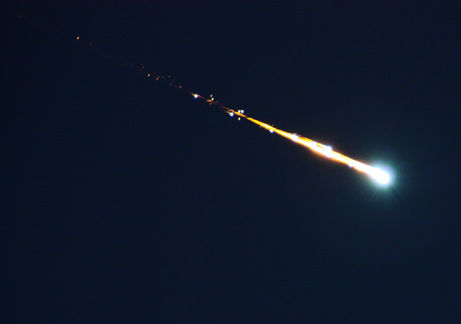Report your meteor sightings please. Please help get the word about this event so that we might recover security camera video or cell phone captures; spread the word about this website via Facebook, Twitter, YouTube, Reddit, GLP, SOTT and your favorite forums; contact your local news outlets; thank you!
If you have video or photo captures please
email me.
Initial Meteor Sighting Reports12JAN2014 NorMya North Haven Connecticut 19:00:00 5 secs W-E facing North green orange white moon trail of sparks long tail of white sparks which flowed into rings of green orange into a dark ball and dissappeared
12JAN2014 Jenn New York, NY 18:45:00 4 seconds Driving easy, it was going southwest Orange Same as venus Yes, broke into 4 pieces after 3 seconds of viewing Amazing experience ... And it feel it was bigger than I expected one to be. It looked as big as a street light going pretty fast
12JAN2014 James Keene N.H 18:30 pm/eastern 3 Hrs East,continuous,West,Facing the east Large brightly glowing sporadically,traveling slowly to the west, Would shine Brighter then the stars Possible tailing You tell me what it is
12JAN2014 Suzanna Barrett Durham ct USA 17:50:00 30 sec? Left to right and down , we were facing east Orange Size and brightness of 7-8 stars together, and orange Yes Have seen tons of meteor showre before, nothing like this before
12JAN2014 Geoff Mount Vernon, NY, USA 1745H EST approx. 3-5 secs Start NNE-E Observer facing east Steady, light blue object appeared on a descending slope. No sound detected (observed from inside car with radio playing), observed an aircraft in the same line of sight heading in a northerly direction brightness comparable to Sirius No disintegration observed My heading was approx.050 degrees. Object relative bearing was approx. 300 degrees at approx. 30-degree elevation


Comment: Apparently filmed on the 2nd of January. See Link for images from different angles.